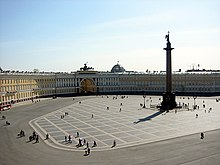Alexander Column
The Alexander Column ( Russian : Александровская колонна, Aleksandrowskaja kolonna also: Александрийский столб Aleksandriski stolb ) is the center of the Palace Square in Saint Petersburg , Russia . It was set up after Russia's victory over Napoleonic France . It was named after Emperor Alexander I , who ruled the Russian Empire from 1801 until his death in 1825 . The column represents an interesting piece of architecture and engineering.
pillar
The column was designed by the French- born architect Auguste de Montferrand and erected between 1830 and 1834; the inauguration took place on August 30, 1834. The monument is 47.5 m high and is crowned by an angel holding a cross and crushing a snake. The angel statue was made by the Russian sculptor Boris Orlowski . The angel's face bears a strong resemblance to Emperor Alexander I.
The column consists of a single piece of red rapaki granite , is 25.45 m high and 3.5 m in diameter. The monolith comes from a quarry near Virolahti west of Vyborg and was brought to St. Petersburg in 1832 on a barge specially developed for this purpose, on which it was further processed. The 600- ton column was erected so carefully in just two hours by 3000 men under the direction of Scottish engineer William Handyside , without the aid of modern cranes or other machinery , that it did not need any further anchoring in the pedestal .
Pedestal
The pedestal of the Alexander Column, designed by the Italian sculptor Giovanni Battista Scotti , is decorated with symbols of military glory.
On the side facing the Winter Palace, a bas-relief can be seen showing a plaque of honor holding winged figures on which "For Alexander I of a grateful Russia" can be read. The composition contains figures symbolizing the Memel and Vistula rivers , which were of particular importance during the war. These figures are flanked by depictions of old Russian armor - the shield of Oleg of Novgorod , the helmet of Alexander Nevsky , the breastplate of Alexander I, the chain armor of Yermak Timofejewitsch and other items of Russian heroes who gained fame for Russia.
The other three sides are decorated with bas-reliefs of emblematic figures of wisdom and prosperity, justice and grace, peace and victory, the latter with a shield in his hands on which the dates 1812, 1813 and 1814 can be read. These compositions are complemented by representations and symbols of ancient Roman military and Russian armor.
The sketches of the bas-reliefs were made by Auguste de Montferrand. He coordinated the dimensions of the figures and composition with the shape of the monument. The figures were made by the sculptors Piotr Swinzow and Iwan Leppe , the decorations and ornaments by Yevgeny Balin . The bronze work was made at Charles Baird's workshop in St. Petersburg.
Later years
In 1952 the rulers of the Soviet Union planned to secretly replace the statue of the angel with a statue of Joseph Stalin . These plans only recently became public but never came to fruition.
A historical iron grating was dismantled during the Soviet period and put back up in 2002.
Today, the Alexander Column, together with the Hermitage, is one of the most popular cultural destinations in St. Petersburg.
literature
- А. Л. Ротач: Александровская колонна. Leningrad 1966
- М. С. Зискинд: Декоративно-облицовочные камни. Ленинград 1889. c. 112-113
- Д. В. Любин: Александровская колонна. Санкт-Петербург 2013.
See also
Web links
Coordinates: 59 ° 56 ′ 20.5 ″ N , 30 ° 18 ′ 56.8 ″ E


